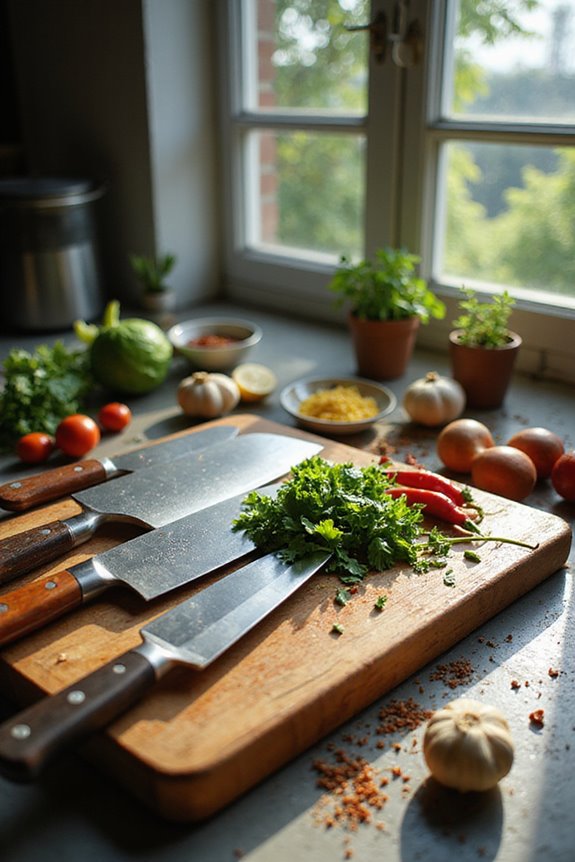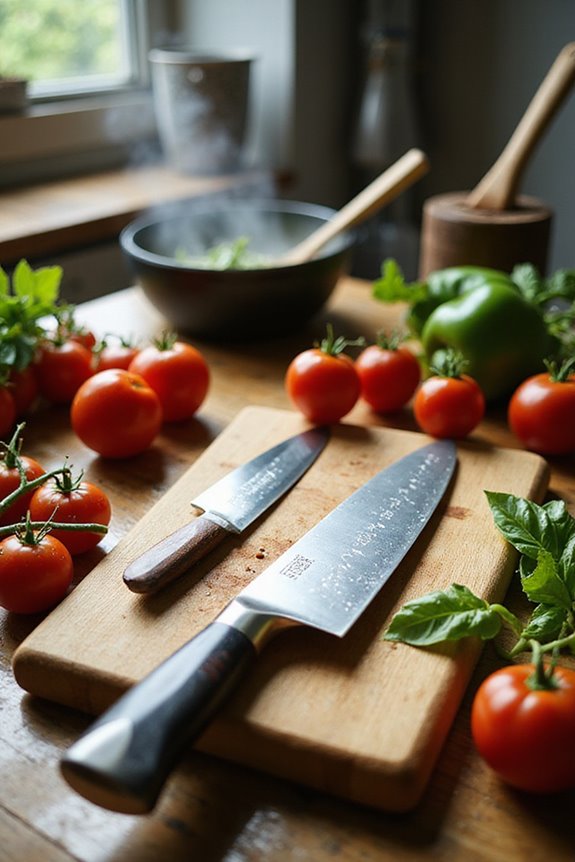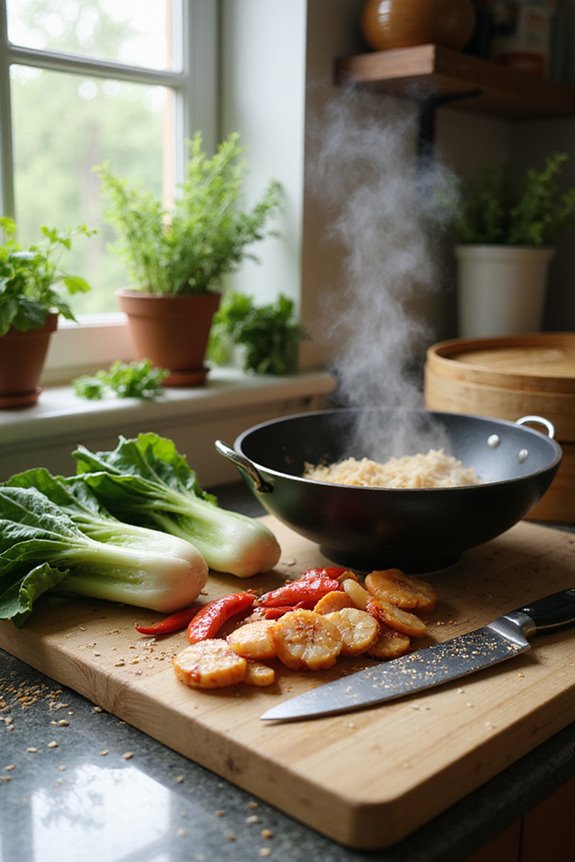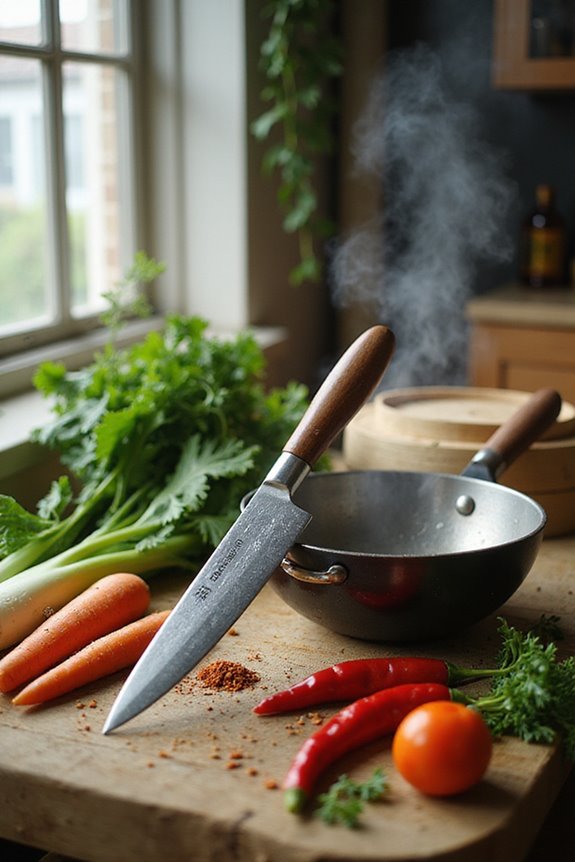As an Amazon Associate, we earn from qualifying purchases. Some links may be affiliate links at no extra cost to you. Although our opinions are based on curated research, we haven't used these products. Articles generated with AI.
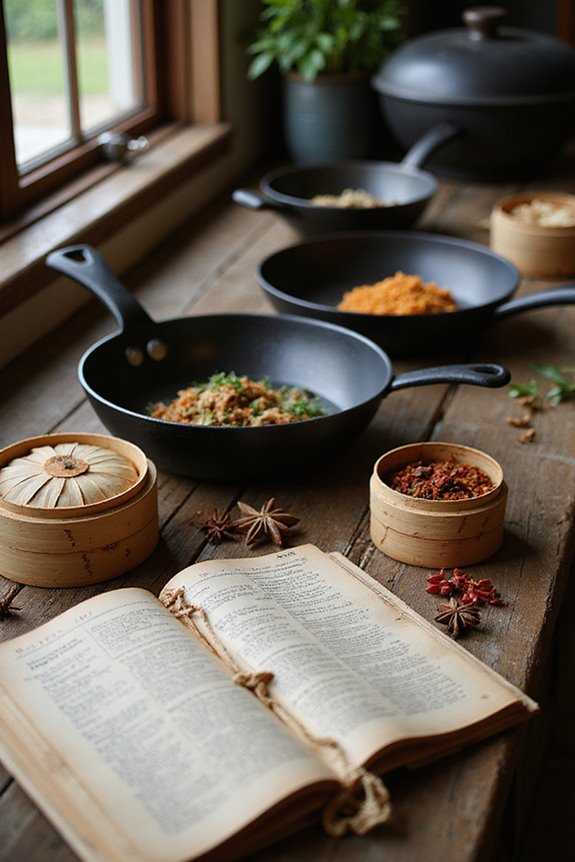
The 3 Best Bamboo Flooring Adhesives: A Comprehensive Guide for Your Next Project
For your bamboo flooring project, consider three top adhesives: Fix-A-Floor All-in-One for its easy application and quick cure time, Roberts 2057-1 for its safe, solvent-free formula, and CalFlor GL82114CF for unmatched moisture resistance. Each offers unique advantages like flexibility to accommodate natural movement of bamboo and quick drying times to speed up installation. Choosing the right adhesive guarantees durability and longevity for your flooring. Keep on exploring to find the best fit for your needs.
Key Takeaways
- Fix-A-Floor All-in-One is ideal for easy application, providing a strong bond and quick curing within 5-24 hours for versatile flooring types.
- Roberts 2057-1 Vinyl Composition Tile Adhesive offers enhanced grip and rapid drying, making it perfect for indoor residential and moderate commercial use.
- CalFlor GL82114CF Eurobond D3 features exceptional moisture resistance, rapid set time, and low VOC content for safe application in high-humidity areas.
- Choose adhesives based on toxicity, focusing on non-toxic, solvent-free options to improve indoor air quality and ensure safety.
- Consider moisture resistance and flexibility for adhesive performance, accommodating bamboo’s natural expansion and contraction for long-lasting durability.
Fix-A-Floor All-in-One Repair Adhesive for Flooring
The Original Fix-A-Floor Squeezy All-in-One Repair Adhesive for Loose, Hollow, Creaky Tiles & Wood....
- The same award-winning Fix-A-Floor in a Simple squeezy tube combined with our precision tip allows for a clean and meticulous application without the need for any other...
- Fix-A-Floor is the professional & DIY trusted choice to fix loose, hollow or creaky floors. Ceramic, Porcelain, Marble, Stone & Wood
- Extra Strength low viscosity formula: Fix-A-Floor self-levels before curing with elastomeric properties allowing the added benefit for use on under floor heating systems....
If you’re dealing with loose, hollow, or creaky floors and need an easy, effective solution, Fix-A-Floor All-in-One Repair Adhesive is your go-to choice. This adhesive’s user-friendly squeezy tube and precision tip make it simple to apply without any extra tools. You can quickly fix various materials, including wood, tiles, and laminate, thanks to its versatile formula. The “drill and fill” method allows for clean application, perfect for DIY lovers or professionals. Plus, it cures faster than traditional options, taking just 5-24 hours, saving you time and effort while providing a strong, long-lasting bond.
Best For: Homeowners and DIY enthusiasts looking for a quick and effective solution for repairing loose or creaky floors across various materials.
Pros:
- Easy application with a user-friendly squeezy tube and precision tip.
- Versatile formula that works on multiple flooring types, including wood, tile, and laminate.
- Quick curing time of 5-24 hours, significantly faster than traditional repair methods.
Cons:
- May require drilling into the floor, which some users may find challenging.
- Limited to repairs rather than complete flooring replacements.
- Specific application techniques may take some practice for optimal results.
Roberts 2057-1 Vinyl Composition Tile Adhesive
Sale
Roberts 2057-1 1 Gallon Vinyl Composition Tile (VCT) Adhesive, for Installing Vinyl-Composition or...
- SBR latex, solvent-free adhesive offering quick dry time and enhanced grab
- For installation of vinyl composition tile (excluding self-stick), including tile-over-tile installation
- For direct bond and double bond installation, bonds with concrete, APA rated plywood, one layer of existing and finish free VCT, aged cutback adhesive residue, primed...
Roberts 2057-1 Vinyl Composition Tile Adhesive is an excellent choice for those looking to install vinyl composition tiles in indoor residential or moderate commercial settings. This solvent-free SBR latex adhesive offers quick drying, enhanced grip, and Microban protection against stains and odors. It’s compatible for use on various surfaces like concrete, plywood, and even over existing finish-free VCT. You can easily apply it using direct bond or double bond methods based on your project needs. Plus, it’s perfect for locations that require a durable, long-lasting solution. With Roberts 2057-1, you’ll achieve a reliable and effective flooring installation.
Best For: Those seeking a reliable adhesive for installing vinyl composition tiles in indoor residential or moderate commercial environments.
Pros:
- Quick drying time allows for fast installations.
- Enhanced grip for a secure bond on various surfaces.
- Microban protection helps prevent stains and odors, ensuring a cleaner environment.
Cons:
- Not suitable for self-stick vinyl tiles.
- Limited to indoor use, may not be ideal for outdoor installations.
- May require specific surface preparations for optimal adhesion on certain materials.
CalFlor GL82114CF Eurobond D3 Floating Floor Glue
Sale
CalFlor GL82114CF Eurobond D3 Floating Floor Glue – Type II/D3 Water‑Resistant, Flexible...
- EuroBond D3 Glue's 16 oz bottle covers 124–200 linear feet; precision tip allows 1/16” bead for laminate or 1/8” for wood applications.
- Bonds tongue & groove or click systems in laminate, engineered wood, cork, and pre-finished floating floors.
- Ideal for wet areas like kitchens/baths; Meets European D3 / Type II water‑resistance; more effective against water damage vs standard PVA
CalFlor GL82114CF Eurobond D3 Floating Floor Glue stands out as an excellent choice for anyone tackling flooring projects in high-humidity areas, such as kitchens and bathrooms. This high-strength, flexible adhesive has a unique cross-linking formula that provides exceptional water resistance, making it ideal for challenging environments. It covers 125-200 linear feet in just 16 fluid ounces, and its low VOC content guarantees a safer application. Users appreciate its quick set time of 10-15 minutes and full cure in 24 hours. Just remember to glue every third plank and wipe excess glue away easily with a damp rag.
Best For: Homeowners and DIY enthusiasts looking for a reliable adhesive for flooring projects in high-humidity areas.
Pros:
- Exceptional water resistance makes it ideal for kitchens and bathrooms.
- Quick set time of 10-15 minutes and full cure in 24 hours for efficient project timelines.
- Low VOC content ensures a safer application environment.
Cons:
- Some users report challenges with uneven surfaces during application.
- Requires gluing every third plank, which may be an additional step for some.
- A small opening on the cap may lead to difficulties in precise application for inexperienced users.
Factors to Consider When Choosing Bamboo Flooring Adhesive
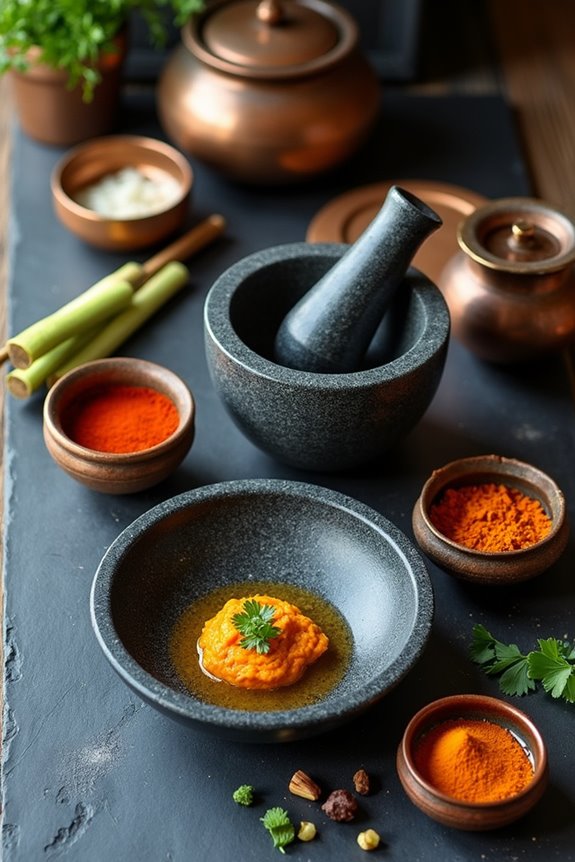
When you’re selecting an adhesive for bamboo flooring, several factors come into play. You’ll want to think about the type of adhesive that matches your project needs, its moisture resistance, and how well it cures over time. Additionally, consider its compatibility with your flooring and how easy it is to apply, ensuring a successful installation.
Adhesive Type Selection
Choosing the right adhesive type for bamboo flooring isn’t just a minor detail; it’s essential for the overall success of your installation. You’ll generally find three common types: water-based, solvent-based, and urethane adhesives. Water-based adhesives are favored for their low VOC content and easy cleanup, making them a safer indoor choice. Solvent-based adhesives, although they create strong bonds, may release harmful fumes and are better suited for high-moisture areas. Urethane adhesives provide remarkable flexibility and moisture resistance, perfect for environments with humidity and temperature shifts. Always make sure the adhesive you select is compatible with both the bamboo flooring’s finish and the subfloor material to avoid issues like warping or delamination in the future.
Moisture Resistance Importance
Selecting the right adhesive type is only part of the equation; understanding moisture resistance is pivotal for guaranteeing your bamboo flooring‘s longevity. Bamboo is a natural material that can absorb moisture, which may lead to issues like expansion, contraction, and even warping if not properly sealed. In high-humidity areas such as kitchens and bathrooms, you’ll want adhesives with superior water resistance to maintain a strong bond and prevent damage. Choosing adhesives that meet industry standards for moisture resistance can help minimize the risk of mold and mildew. Additionally, products designed for humid environments markedly enhance durability and guarantee a stable, aesthetically pleasing surface. Ultimately, a moisture-resistant adhesive preserves your flooring installation over time, protecting your investment.
Curing Time Considerations
Understanding curing time is essential since it directly impacts the success of your bamboo flooring installation. Curing times can vary notably, often ranging from a few hours to over 24 hours. While a shorter curing time might speed up your project, you should confirm the adhesive reaches full strength before allowing foot traffic. Factors like temperature, humidity, and ventilation can affect the curing process; higher temperatures usually speed things up. Some adhesives need specific conditions to cure effectively, so always follow the manufacturer’s guidelines for the best results. By considering curing time, you can better plan your installation timeline, ultimately leading to a more durable and high-performing bamboo floor.
Compatibility With Flooring
After verifying your bamboo flooring adhesive cures properly, the next step involves checking its compatibility with your flooring type. Different adhesives are formulated for specific materials, so determine whether you’re using solid or engineered bamboo. You’ll also want to confirm the adhesive works well with your substrate, be it concrete, plywood, or another surface. Evaluating the adhesive’s moisture resistance is essential, especially in high-humidity areas, as this can affect your flooring’s longevity. Additionally, check if the adhesive meets environmental standards, like being low in VOCs, to guarantee good indoor air quality. Finally, consider the curing time; faster options can speed up installation, helping you minimize downtime for both residential and commercial projects.
Ease of Application
When choosing bamboo flooring adhesive, ease of application plays an essential role in the overall installation process. Look for adhesives that offer user-friendly methods, like precision tips or squeezy tubes, allowing for neat application without extra tools. A quick curing time is critical, as it speeds up your project and minimizes downtime. Flexible formulations are a plus since they adapt to the bamboo’s natural expansion and contraction due to humidity changes. Additionally, low-viscosity adhesives self-level before curing, creating an even bond and reducing air pockets that could result in flooring issues. Finally, consider non-toxic and eco-friendly options to create a safer work environment and enhance indoor air quality. These factors will streamline your installation experience.
Toxicity and Safety
Choosing the right bamboo flooring adhesive goes beyond just performance; safety and toxicity are just as significant. You should always opt for adhesives labeled non-toxic and eco-friendly to avoid harmful fumes during application or after curing. Solvent-free options are highly recommended, as they minimize exposure to volatile organic compounds (VOCs), which can compromise indoor air quality. Look for adhesives certified for low VOC content to guarantee they’re safer for both you and the environment. It’s vital to select products free from formaldehyde and acrylamide due to their associated health risks. Finally, review safety data sheets (SDS) for each adhesive to understand its composition and any potential hazards, assuring compliance with safety standards.
Flexibility for Movement
Understanding the flexibility needs of bamboo flooring adhesive is essential, especially since bamboo naturally expands and contracts with changes in temperature and humidity. A flexible adhesive allows for this movement, minimizing the risk of damage or separation. When you’re choosing an adhesive, look for options with elastomeric properties. These can bond well while accommodating slight shifts, which is especially vital in high-humidity areas like kitchens and bathrooms. A high-strength, flexible adhesive enhances the flooring’s stability, important for spaces with heavy foot traffic or temperature fluctuations. Furthermore, an adhesive that retains its flexibility after curing absorbs shock and reduces noise, creating a more comfortable living environment. Prioritize these features for long-lasting bamboo flooring performance.
Performance in Humidity
Selecting the right adhesive for bamboo flooring can markedly impact its performance in humid environments. Since bamboo is sensitive to humidity changes, it’s essential to choose a water-resistant adhesive that maintains stability. Look for high-strength adhesives that offer flexibility; these options can adapt to the natural movement of bamboo caused by moisture. Additionally, adhesives meeting European D3 standards provide enhanced protection against water damage and delamination. Consider the adhesive’s curing process as well; those with shorter set times tend to perform better during humidity fluctuations. Finally, opt for low-VOC adhesives to minimize harmful emissions while guaranteeing necessary adhesion performance in humid conditions. By paying attention to these factors, you can make certain your bamboo flooring stays beautiful and functional.
Frequently Asked Questions
Can Bamboo Flooring Adhesives Be Used on Non-Bamboo Surfaces?
Yes, you can use bamboo flooring adhesives on non-bamboo surfaces, but it’s crucial to verify compatibility first. These adhesives usually bond well with various materials like concrete, wood, or existing flooring. To guarantee a solid hold, clean the surface thoroughly and let it dry before application. Follow the manufacturer’s guidelines regarding curing times and temperature conditions for the best results. This preparation helps achieve a durable and lasting finish for your flooring project.
How Long Does It Take for Bamboo Flooring Adhesive to Cure?
Bamboo flooring adhesive typically takes 24 to 48 hours to cure fully, but this can vary depending on the specific product and environmental conditions. You should maintain good ventilation and a stable temperature to enhance curing efficiency. While you can walk on it after a few hours, it’s best to avoid heavy furniture and foot traffic until the adhesive is completely cured. Always double-check the manufacturer’s recommendations for the best results.
Are Bamboo Flooring Adhesives Water-Resistant?
Think of bamboo flooring adhesives like a raincoat for your floors. They can be water-resistant, but not all are created equal. Some adhesives offer excellent moisture resistance, protecting your flooring from spills and humidity, while others might struggle. It’s crucial to check the manufacturer’s specifications closely. If you’re concerned about water exposure, opt for a product specifically designed for wet areas, ensuring durability and longevity in your bamboo flooring investment.
What Tools Are Needed for Applying Bamboo Flooring Adhesive?
To apply bamboo flooring adhesive, you’ll need a few essential tools. First, grab a notched trowel for spreading the adhesive evenly. You’ll also want a tape measure for precise cuts and a good utility knife for trimming flooring planks. Safety goggles and kneepads will keep you protected and comfortable during the installation. Finally, a roller can help guarantee good contact between the flooring and the adhesive, leading to a stronger bond.
Can I Remove Bamboo Flooring Without Damaging the Adhesive?
You can certainly remove bamboo flooring without causing too much trouble for the adhesive. Start by gently prying up the edges, using a flat pry bar. Work your way along, avoiding sudden movements that might disturb the adhesive. If you encounter resistance, applying heat can soften it, allowing for easier removal. Just remember, patience is key, and taking your time will help maintain the integrity of the adhesive beneath your bamboo flooring.




